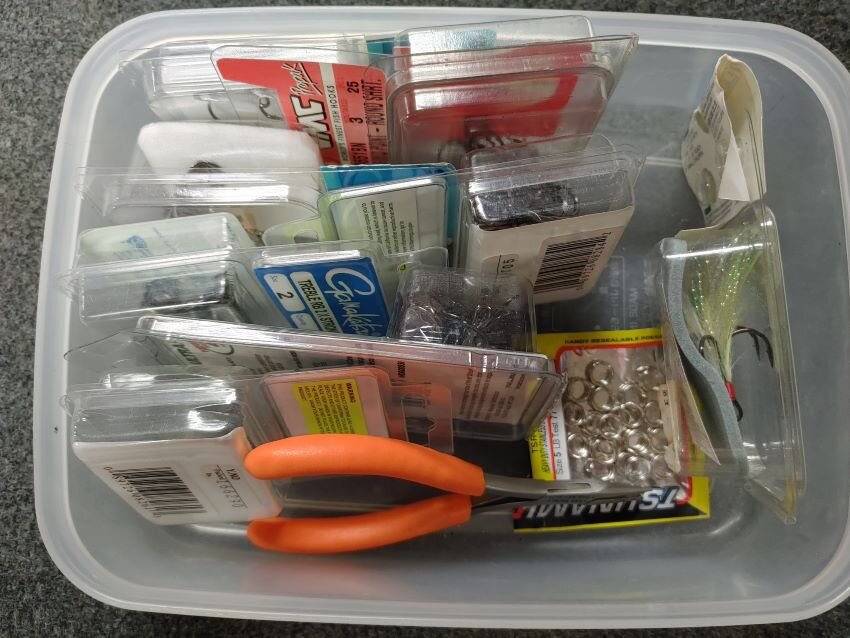Trebles for Mexican Bass Travels
While most of us are rigorous about packing high-quality, laser-sharp hooks for our single hook presentations at El Salto and Picachos, it’s easy to slack on replacement trebles. If you’re going for just three days of fishing you may be able to get away without bringing any – you can simply cannibalize other lures to get the job done – but any more than that and I’d recommend that you bring a small stash. Between the trees and rock cover, the exceptionally “toothy” bass, and the fact that some will get bent by pliers, there’s a pretty good chance you’ll need them. Additionally, they don’t take up much room.
I’ve historically brought a small, approximately 5”x7”x3” Tupperware-style latching box for all of them. Alternatively, you can use a deep 3700-style box to store them alone, or with other lures. If you cut off the tab at the top of the clamshell hook package and then store the size information inside that makes it easier in most cases. You can also eliminate the packaging and put the hooks on a twist-tie as long as you find a way to label them by size. Be sure to use not just the latches on the box but also tape or rubber bands to keep it from opening. It’s not safe, fair or wise to have loose trebles flying around your luggage, endangering TSA agents or potentially ending up lurking precariously in your undershorts.
My replacement hooks are most likely to be used for topwaters, lipless cranks, squarebill style cranks and deep-divers – more topwaters in the colder months and more deep presentations in the summer, so I skew their numbers accordingly just a bit. I carry every size from 6 up to 2/0, with all of the unusual “off” sizes (e.g., #5, #3, #1) included. They don’t weigh much or take up much space, so why not be prepared for all reasonable possibilities?
I tend to carry round bends – mostly Gamakatsus and Owners – for the mid-range sizes. The standard wire is fine for some presentations, but the 2X or 3X versions (4X seems like overkill to me) are preferable when they don’t disturb the balance or action of your lure. The fish in Mexico are simply stronger and meaner than your largemouths at home, so prepare accordingly. The Gamakatsu Round Bends and Owner ST36 and ST41 trebles have served me very well and if I had to choose one hook style for everything, the ST36 would likely be it. I’ll also carry some of those in larger sizes for big topwaters like the Whopper Plopper 130, for which I do not like an EWG-style treble.
For my more weight-sensitive jerkbaits and finesse-oriented poppers I’ve grown to love the Gamakatsu Aaron Martens TGW Finesse Trebles. They’re lightweight so they don’t negatively impact the balance of your lures, but they’re remarkably strong and penetrate easily. With any hook in the #6 or #5 size range you will likely have to change them regularly if they’re getting a lot of use, so bring a decent number of these and change them out at the first signs of trouble. That’s especially true if you’re using a Megabass Vision 110, by far my favorite jerkbait in Mexico (or most places, for that matter) because the factory Katsuage Out Barb trebles seem to get mangled pretty quickly – and there are three of them to replace.
Don’t neglect to bring feathered trebles, either. Because the ½ ounce Rio Rico is my number one topwater on El Salto and Picachos, I tend to lean heavily on #4 feathered trebles, but I also bring a couple each of #6 and #2 versions for other uses. I stick to mostly white, although chartreuse matches some baits, and a little bit of red in either doesn’t hurt anything. The feathers will get chewed up pretty quickly and I think they make a difference when the bites are coming while the lure is at rest, so change as needed.
Finally, for the big dawg crankbaits like the Berkley Dredger, Fat Free Shad, 6XD and 10XD, I think the Gamakatsu 2X trebles and the Owner ST36 and ST41 are good options, but I’ve become a huge fan of the Mustad KVD Triple Grips (both short shank and regular shank, usually in the 2X strength). After all, if they’re good enough for VanDam they should be good enough for me. They seem to hold a point for a long time, even after getting repeatedly banged into hard cover, and once hooked the fish are less likely to get off. In the interest of full disclosure, I’m not enough of a big bait expert to know what I’d use as replacements on mega-sized wake baits and glide baits, but I’d lean toward the round bend 2X regular shank models.
As long as you’re changing hooks, you’ll want to examine your split rings, too. Big fish will always exploit your weakest link, so if the split rings have been damaged or weakened in any way you’ll want to change them. I bring an assortment in a variety of sizes in a Ziploc bag. While there are a lot of inexpensive brands that are reliable and strong, I also bring some of the “Hyperwire” style rings for big bait, big fish presentations.
Unless you are talented at changing out hooks and split rings with your fingernails (not worth it, in my opinion), invest in a good set of split ring pliers to make the job simple. I’ve used a pair from Texas Tackle for years and bought a second, larger pair for big peacock bass and saltwater baits. At $18 to $23 a pair, buy one set for your travel bag and one for home – and if you know a fishing friend who doesn’t own any it’s a great and typically much-appreciated gift.
No matter where you’re headed to fish, packing sharp, high-quality replacement hooks is often an afterthought, but one that pays huge dividends if done correctly. You can tailor it to your particular angling adventure. For example, in Brazil, I brought mostly 4X hooks because the peacocks and toothy critters can bend out anything lighter with ease. When we visited Africa, I brought lots of Siwash single replacement hooks and mashed the barbs down for fisheries where neither trebles nor barbs were allowed. And just because you bring them doesn’t mean they should sit in your luggage. Take 15 minutes every night and get your best lures in toptop shape for fishing action – it could save you the fish of a lifetime.





